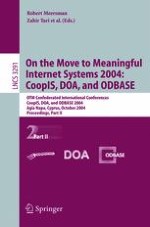A special mention for 2004 is in order for the new Doctoral Symposium Workshop where three young postdoc researchers organized an original setup and formula to bring PhD students together and allow them to submit their research proposals for selection. A limited number of the submissions and their approaches were independently evaluated by a panel of senior experts at the conference, and presented by the students in front of a wider audience. These students also got free access to all other parts of the OTM program, and only paid a heavily discounted fee for the Doctoral Symposium itself. (In fact their attendance was largely sponsored by the other participants!) If evaluated as successful, it is the intention of the General Chairs to expand this model in future editions of the OTM conferences and so draw in an audience of young researchers to the OnTheMove forum. All three main conferences and the associated workshops share the d- tributed aspects of modern computing systems, and the resulting applicati- pull created by the Internet and the so-called Semantic Web. For DOA 2004, the primary emphasis stayed on the distributed object infrastructure; for ODBASE 2004, it was the knowledge bases and methods required for enabling the use of formalsemantics;andforCoopIS2004themaintopicwastheinteractionofsuch technologies and methods with management issues, such as occurs in networked organizations. These subject areas naturally overlap and many submissions in factalsotreatenvisagedmutualimpactsamongthem.
